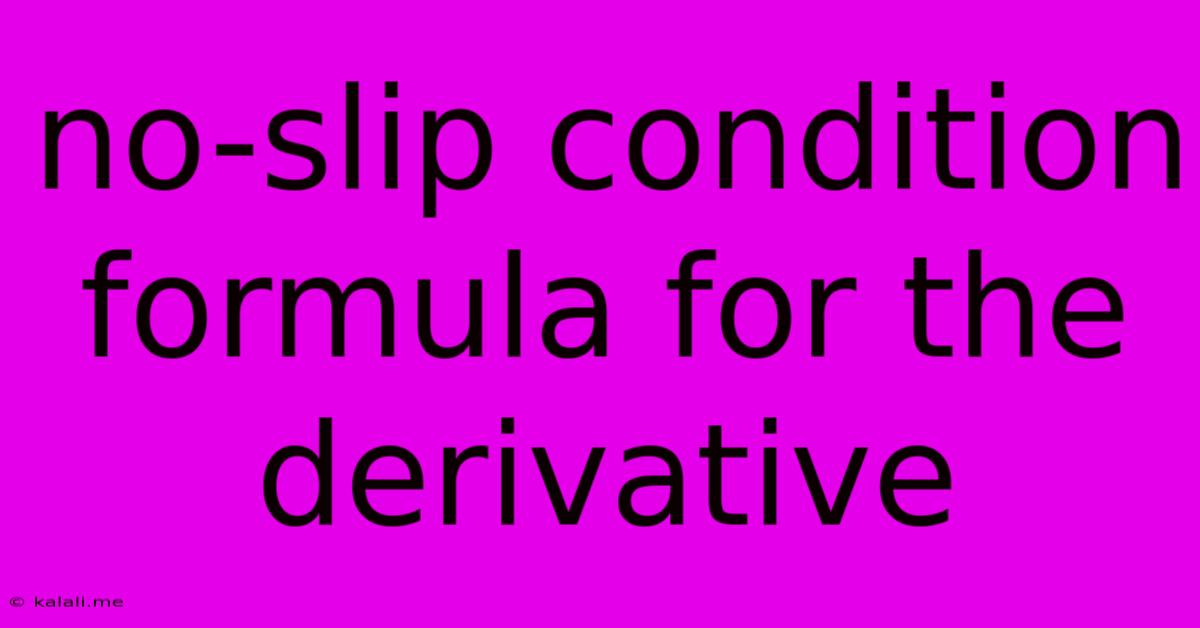No-slip Condition Formula For The Derivative
Kalali
May 27, 2025 · 3 min read

Table of Contents
Understanding the No-Slip Condition and its Derivative Formula
The no-slip condition is a fundamental concept in fluid mechanics, stating that at a solid boundary, the fluid velocity is equal to the velocity of the boundary itself. This means that the fluid directly adjacent to a stationary surface is at rest, and the fluid adjacent to a moving surface moves at the same velocity as that surface. This seemingly simple concept has significant implications for understanding fluid flow behavior and is crucial in various applications, from designing aircraft wings to analyzing blood flow in arteries. This article will delve into the mathematical representation of the no-slip condition, focusing on its derivative formula and its practical applications.
Defining the No-Slip Condition Mathematically
The no-slip condition can be expressed mathematically using the velocity vector u of the fluid. Let's consider a fluid flowing near a solid surface. If the surface is stationary, the no-slip condition states that the fluid velocity at the surface is zero:
u(x, y, z) = 0 at the surface
Where (x, y, z) represents a point on the surface. If the surface is moving with a velocity U, then the condition becomes:
u(x, y, z) = U at the surface
This simple equation is the foundation of many complex fluid dynamics simulations.
The Derivative of the No-Slip Condition: Shear Stress
While the no-slip condition itself is a statement about the velocity, its derivative is where we find its most significant practical implications. The derivative of the velocity field near the surface represents the velocity gradient, which is directly related to the shear stress within the fluid.
Shear stress (τ) is the force per unit area that the fluid exerts tangentially on the surface. It arises due to the friction between fluid layers moving at different velocities. Newton's law of viscosity links shear stress to the velocity gradient:
τ = μ (∂u/∂y)
where:
- τ is the shear stress
- μ is the dynamic viscosity of the fluid (a measure of its resistance to flow)
- ∂u/∂y is the velocity gradient in the direction perpendicular to the surface (often denoted as y). This is the derivative of the velocity component parallel to the surface with respect to the distance perpendicular to the surface.
This equation highlights the crucial role of the no-slip condition's derivative. The fact that the velocity at the surface is zero (or equal to the surface velocity) creates a significant velocity gradient immediately adjacent to the surface. This gradient is responsible for the shear stress that the fluid exerts on the surface and vice versa.
Applications and Implications
The no-slip condition and its derivative have far-reaching consequences across various fields:
-
Aerodynamics: Designing aircraft wings relies heavily on understanding boundary layer flow, where the no-slip condition plays a pivotal role in determining drag and lift forces. The shear stress at the wing surface significantly influences the aerodynamic performance.
-
Hydrodynamics: Analyzing ship hull design, pipeline flow, and even the motion of microorganisms in fluids necessitates incorporating the no-slip condition. The shear stress governs the frictional resistance experienced by these objects.
-
Biofluid Mechanics: Blood flow in arteries and veins is profoundly influenced by the no-slip condition. The shear stress at the vessel walls affects endothelial cell function and can play a crucial role in the development of cardiovascular diseases.
-
Microfluidics: In microfluidic devices, the no-slip condition becomes particularly important due to the small length scales involved. The thin boundary layers significantly impact the flow patterns and mixing efficiency within these devices.
Conclusion
The no-slip condition, while seemingly simple, is a cornerstone of fluid mechanics. Its derivative, representing the velocity gradient and shear stress, is crucial for understanding and predicting the behavior of fluids near solid surfaces. Its influence spans numerous engineering and scientific disciplines, highlighting its enduring importance in our understanding of fluid flow. Further exploration of boundary layer theory and advanced numerical techniques are required to fully grasp the complexities of flow governed by this fundamental principle.
Latest Posts
Latest Posts
-
David Changed His Behavior Before Abimelech
May 28, 2025
-
Ac High Pressure On Low Side
May 28, 2025
-
How To Keep Fruit Flies Away From Fruit Bowl
May 28, 2025
-
How To Stop Steam Games From Showing In Recently Played
May 28, 2025
-
Why Are Polish People Considered Stupid
May 28, 2025
Related Post
Thank you for visiting our website which covers about No-slip Condition Formula For The Derivative . We hope the information provided has been useful to you. Feel free to contact us if you have any questions or need further assistance. See you next time and don't miss to bookmark.